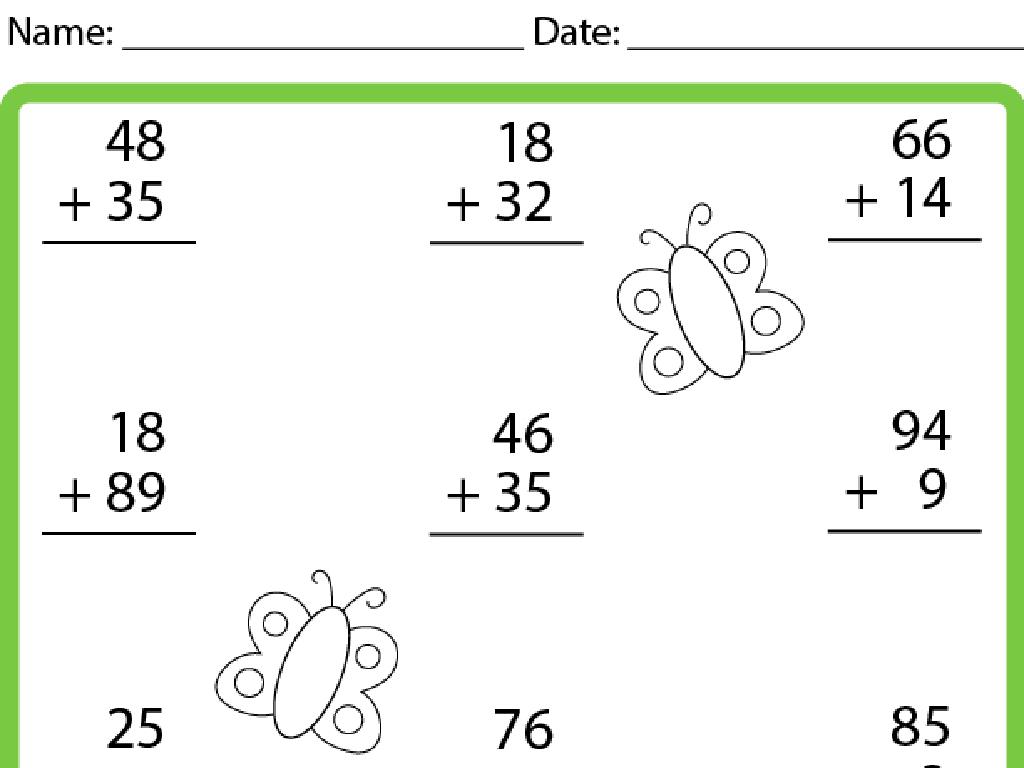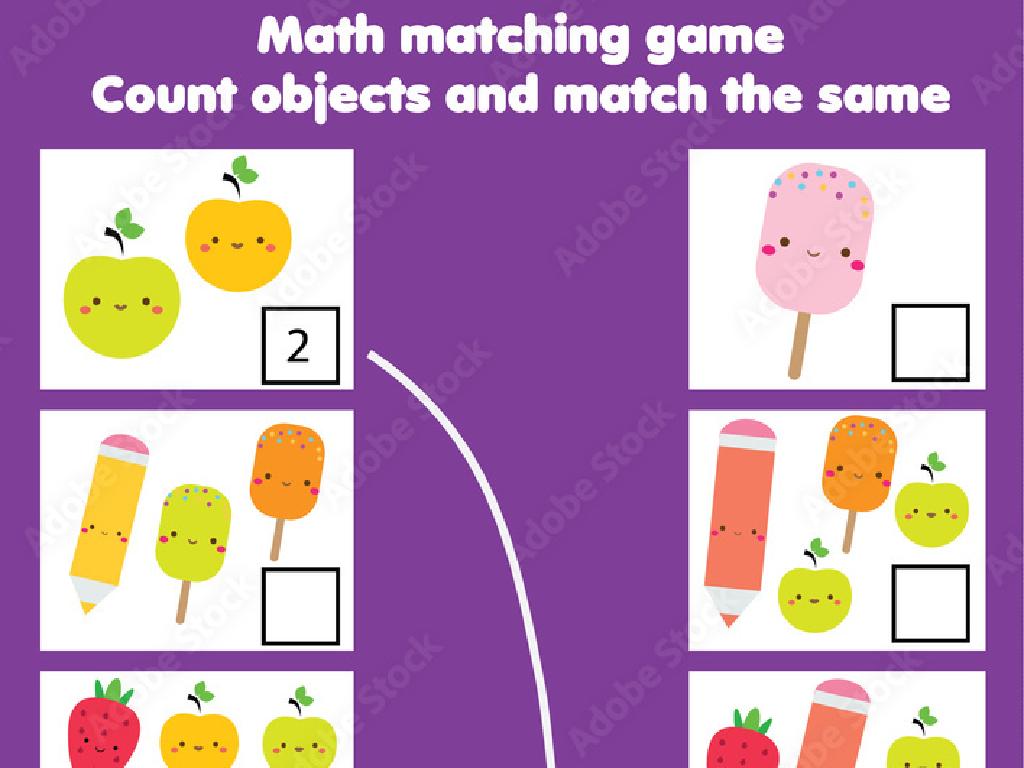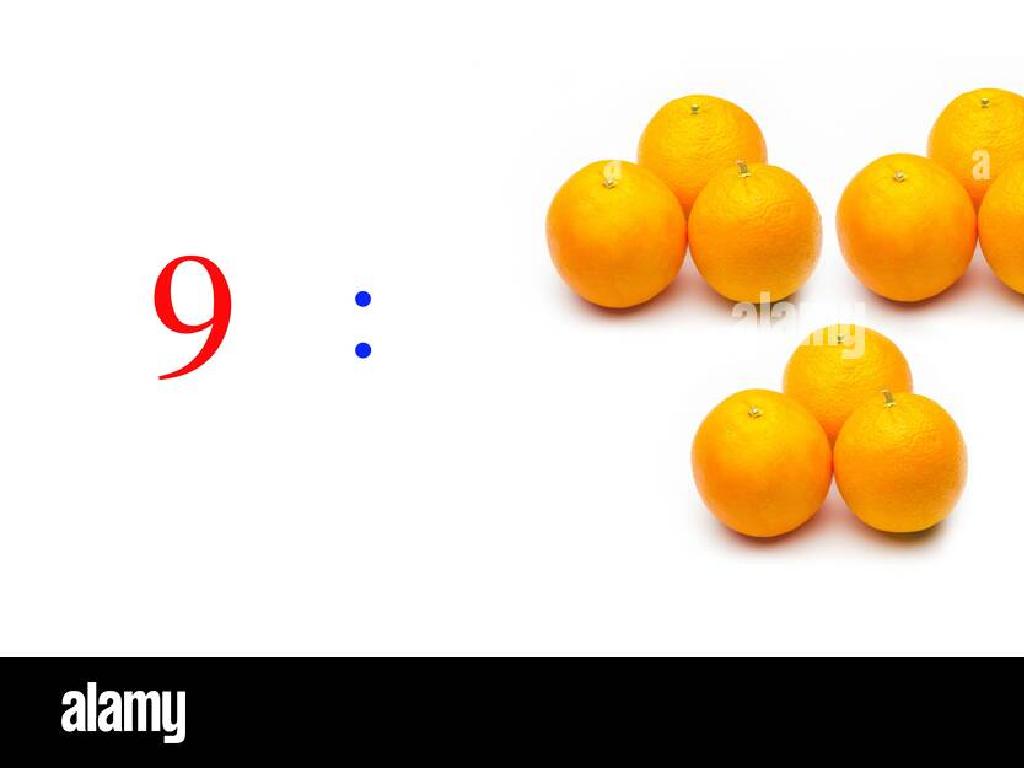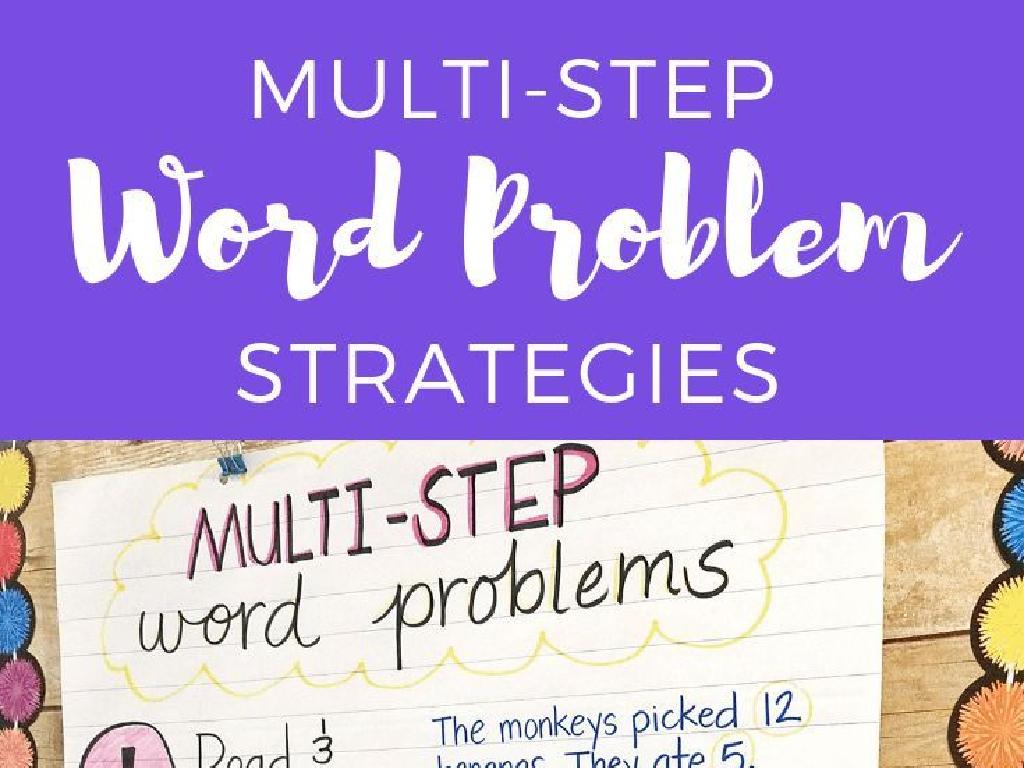Multiply One-Digit Numbers Using Grids
Subject: Math
Grade: Third grade
Topic: Multiplication Properties
Please LOG IN to download the presentation. Access is available to registered users only.
View More Content
Today’s Adventure: Multiplying with Grids!
– Multiplication as groups of numbers
– Think of multiplication like adding groups of the same size. For example, 3 groups of 4 apples.
– Why multiplication matters
– It helps us count faster and solve problems in math and real life!
– Using grids to multiply
– Grids show us how many groups and items in each group visually.
– Practice makes perfect
|
This slide introduces the concept of multiplication as a method for quick and efficient counting. Explain that multiplication is like adding the same number multiple times, and it’s a skill that they will use throughout their lives. Show how using grids can help visualize this process by creating rows and columns that represent the groups and the number in each group. Encourage the students to practice with different numbers to become more comfortable with the concept. Provide examples on the board and have students create their own grids as a class activity. This will help solidify their understanding of multiplication as a fundamental math skill.
Understanding Multiplication
– Multiplication as repeated addition
– It’s like adding the same number over and over!
– Example: 3 x 4 equals 4 added 3 times
– 4 + 4 + 4 = 12 shows how 3 x 4 works
– Multiplication is quick addition
– Instead of adding 4 three times, just multiply!
– Practice with grid method
– Use grids to multiply numbers easily
|
This slide introduces the concept of multiplication to third graders as a method of repeated addition, which is a foundational building block for understanding how multiplication works. Start by explaining that multiplication is a shortcut for adding the same number multiple times. Use the example 3 x 4 to show that instead of adding 4 three times, we can simply multiply 3 by 4 to get the same result faster. Emphasize that multiplication is a more efficient way to add repeatedly. Introduce the grid method as a visual way to understand and practice multiplication, which will be covered in more detail in subsequent slides or activities. Encourage students to think of multiplication as a handy tool they can use whenever they need to add the same number several times.
Using Grids to Multiply One-Digit Numbers
– Grids make multiplication clear
– Imagine a grid as a group of objects, like 3 rows of 4 apples each
– Steps to set up a multiplication grid
– First, draw a square. Write one number at the top, one on the side
– Fill in the grid with rows and columns
– Draw lines to create rows and columns, then fill in with multiples
– Practice with different numbers
|
This slide introduces students to the concept of using grids as a visual tool to understand and solve multiplication problems. Start by explaining how grids can represent multiplication as repeated addition (e.g., 3 rows of 4 apples is like 4 + 4 + 4). Demonstrate how to set up a grid with one number at the top and one on the side, and how to fill in the grid with the product of the row and column numbers. Encourage students to practice setting up and filling in grids with different numbers to solidify their understanding. Provide several examples and allow students to work through problems in pairs or groups for collaborative learning.
Let’s Practice Multiplication with Grids!
– Example: Multiply 2 x 5 using a grid
– Visualize 2 groups of 5 items in a grid format
– Create a grid with 2 rows and 5 columns
– Draw two horizontal lines and five vertical lines to make the grid
– Fill in the grid with squares
– Place a dot or color in each square to represent the items
– Count all the squares for the total
– Add up the filled squares to find the product of 2 and 5
|
This slide is an interactive class activity to help students understand multiplication using grids. Start by explaining the concept of multiplication as combining equal groups. Show them how to draw a grid with 2 rows representing 2 groups and 5 columns representing 5 items in each group. Have them fill in the grid, then count the total number of squares to find the product. This visual method reinforces the concept of multiplication as repeated addition. For the activity, provide different multiplication examples for students to try, such as 3 x 4, 1 x 6, or 5 x 5, and let them draw and fill in the grids accordingly. Encourage students to share their grids and discuss the results.
Try It Yourself: Multiplying on a Grid
– Your task: Multiply 3 x 6 using a grid
– Count each square carefully
– Make sure to count every row and column
– Write down your total
– Share your answer with the class
– Discuss how you got the answer
|
This slide is an interactive class activity designed to help students practice multiplying one-digit numbers using a grid. Students are given the task to multiply 3 by 6 using a grid method. They should draw a grid with 3 rows and 6 columns, then count the total number of squares to find the product. Remind them to count carefully to ensure accuracy. After completing the task, students will write down their total and then share their answers with the class. This will help reinforce the concept of multiplication as repeated addition and provide an opportunity for peer learning. The teacher should circulate the room to assist any students who may be struggling and to confirm the correct answers.
Exploring Multiplication Properties
– Commutative Property
– Order doesn’t change the product: 4 x 3 = 3 x 4
– Associative Property
– Grouping doesn’t change the product: (2 x 3) x 4 = 2 x (3 x 4)
– Distributive Property
– Multiply inside a sum by multiplying each addend: 5 x (2 + 3) = (5 x 2) + (5 x 3)
|
This slide introduces the third-grade students to the fundamental properties of multiplication. The commutative property shows that the order of factors does not affect the product. The associative property demonstrates that the way in which factors are grouped does not change the result. The distributive property allows us to multiply a number by a sum by multiplying each addend separately and then adding the products. Use grid examples to visually explain these properties, and provide simple exercises for students to apply each property. Encourage students to think of these properties as tools that make multiplication easier and more flexible.
Multiplication Grid Game
– Let’s play a grid game!
– Pair up for multiplication fun
– Solve grids to practice multiplying
– Use the grids to multiply numbers like 3×4
– First to finish wins a surprise!
|
This slide introduces a fun and interactive multiplication grid game to help students practice multiplying one-digit numbers. The game is designed to be played in pairs, encouraging teamwork and peer learning. Each pair will receive a grid with multiplication problems to solve. The first pair to complete their grid correctly will be rewarded with a small prize, adding an element of competition to the activity. As a teacher, prepare several grid templates with different multiplication problems. Ensure the game’s rules are clear and that each student understands how to use the grid to multiply numbers. Monitor the class as they play, offering guidance and support where needed. This activity not only reinforces multiplication skills but also promotes a positive and engaging learning environment.
Class Activity: Grid Art!
– Create grid art with colors
– Pick a multiplication problem
– Color squares to show multiplication
Color the number of squares that equals your answer
– Share your art and explain
Tell us how you used multiplication in your art
|
This activity is designed to help students visualize multiplication through a creative and engaging art project. Each student will choose a multiplication problem, such as 3 x 4, and then color in the corresponding number of squares on a grid to create a pattern or picture. This hands-on approach reinforces the concept of multiplication as repeated addition and helps students see the results in a tangible form. After completing their grid art, students will present their artwork to the class and explain the multiplication problem they chose and how they represented it on the grid. For the teacher: Prepare a grid template for each student and have a variety of coloring materials available. Consider different multiplication problems for varying levels of difficulty. Encourage creativity and praise the students’ ability to connect math with art.
Review: Multiplying with Grids
– Recap: Grid multiplication
– We learned to multiply numbers within grids, visualizing the problem.
– Multiplication properties
– Commutative, Associative, and Distributive properties simplify multiplication.
– Solving questions together
– Let’s work through examples as a class to reinforce our skills.
– Open Q&A session
|
This slide aims to consolidate the students’ understanding of multiplying one-digit numbers using grids. Begin by reviewing the grid method, where students visualize multiplication as an array of squares. Reiterate the importance of multiplication properties: Commutative (numbers can be multiplied in any order), Associative (grouping numbers doesn’t change the result), and Distributive (breaking up numbers into parts). Encourage students to ask questions and participate in solving problems as a group to enhance their comprehension. The open Q&A session will allow students to clarify any doubts and demonstrate their understanding.
Homework Challenge: Grid Multiplication
– Practice multiplication with grids
– Finish the worksheet provided
– Use the grid method we learned in class
– Check your work carefully
– Double-check each multiplication
– Get ready to discuss answers
– Think about how you solved the problems
|
This homework is designed to reinforce the grid method of multiplication that students learned in class. Provide a worksheet with a variety of one-digit multiplication problems set up in grid format. Remind students to carefully fill in each grid and multiply step by step, as practiced in class. Encourage them to check their work to ensure accuracy. The next day, plan for a discussion where students can share their methods and answers, fostering a collaborative learning environment. This will also give you insight into their understanding and areas where they might need additional support.






